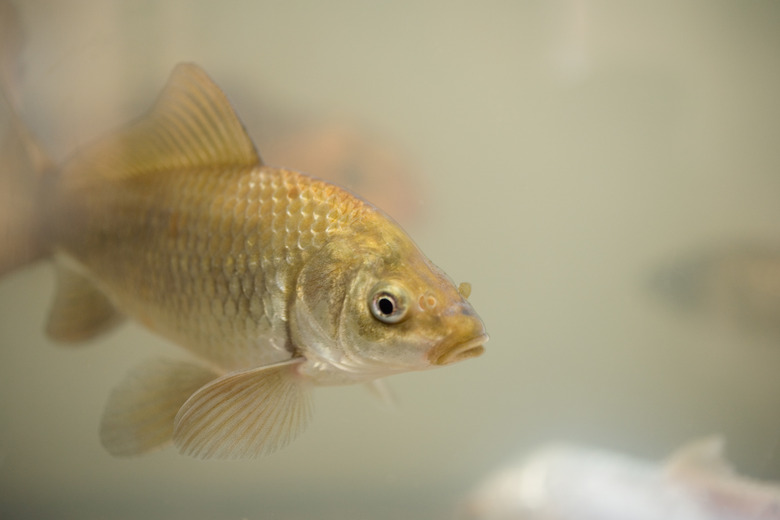How To Make An Ecosystem In A Bottle With Fish & Plants
Every species has different requirements for tank size, food and the chemical conditions of the environment it wants to live in. When creating an ecosystem in a bottle with plants and fish, all of the environmental and social needs must be taken into account.
Due to size constrictions, only some species of small fish may be suitable for living in a bottle.
Ecosystem Definition
Ecosystem Definition
The word ecosystem is used to describe an area where animals, plants and other living creatures interact with each other and their environment.
The living parts of an ecosystem are called biotic and the nonliving portion is called abiotic. Abiotic factors include the sun, soil, temperature, water and air.
Ecosystems can range in size from a single plant to the Amazon rainforest to the bacteria that live in your intestines.
Turning a Bottle Into a Tank
Turning a Bottle Into a Tank
Carefully select a sizable clear bottle that will let plenty of light in. Clean and rinse the bottle thoroughly.
Next, cut the top off the bottle to create a wider opening for easy access for cleaning and to add the plants and fish. A self-sustaining ecosystem is not easy to create and most need some food input or cleaning, at least at first.
Freshwater aquatic environments are easier to maintain than saltwater. Decide on the type of ecosystem you want to create based on the requirements of your plant and animal species.
Fill the bottle with clean water and check that it is free from chemical contaminants such as chlorine using chemical test kits. A small aquarium air line may need to be added to ensure water is oxygenated thoroughly and evenly.
Creating an Aquarium in a Bottle
Creating an Aquarium in a Bottle
Creating an aquarium ecosystem in a bottle is basically the same as creating an aquarium in a tank. Once the water is prepared, add a layer of small stones and sand to the bottom to help anchor the plants.
Next, add plants to help oxygenate the water. Let the plants settle and establish themselves for a few weeks before adding animals to the bottle aquarium.
Ensure the bottle is placed in a bright area, so the plants have ready access to light for photosynthesis. When selecting a location, choose one that is preferably not in a place with too much direct sunlight as this can cause the temperatures to spike.
Plants and animals all have specific thermal thresholds and since these organisms are being constrained to a small area, it is essential to pick an area that will suit their environmental specifications.
Maintaining a Bottle Biosphere
Maintaining a Bottle Biosphere
Because fish are complex animals it is hard to make a self sustaining environment, especially in an area as small as a bottle. This means that bottle ecosystems need to be maintained in much the same way as any fish tank.
For example, fish should be fed twice every day with food designed especially for that species and the tank needs to be cleaned weekly. Only ever feed fish as much as they can eat at one time, because sunken food will create more waste that will need to be cleaned more frequently.
Cleaning a Bottle Biosphere
Cleaning a Bottle Biosphere
Water should always appear clear and smell fresh—if the water is cloudy or smells bad, this indicates an unhealthy environment. During weekly cleans the stones need to be cleaned to remove waste products from the fish and uneaten food that has fallen.
Up to 25 percent of the water should be changed weekly to ensure it stays clean and is a sustainable, happy environment for the plants and animals living there. Small snails and species of fish can be added to help keep the tank clean but remember to check the oxygen levels of the water as the more animals added the more oxygen demand.
References
- Fish Keeper UK: How Often and Much Do I Need to Change My Aquarium Water and Clean My Filter?
- Marineland: Beginners Guide to Successful Fishkeeping
- University of Michigan: The Ecosystem and How It Relates to Sustainability
- Green Growing: How to Make a Self-Sustaining Ecosystem: 5 Steps and Ideas
- Fishkeeping World: The Definitive Guide to Creating a Paludarium (Tank, Plants and Building Suggestions)
- Science Learning Hub: Ecosystems: What Is an Ecosystem?
- Northern Arizona University: Bottle Biospheres
- University of California Press: The American Biology Teacher: Pond in a Jar
- Science and Children: Ecosystem in a Jar
Cite This Article
MLA
Jerrett, Adrianne. "How To Make An Ecosystem In A Bottle With Fish & Plants" sciencing.com, https://www.sciencing.com/make-ecosystem-bottle-fish-plants-12067199/. 22 July 2019.
APA
Jerrett, Adrianne. (2019, July 22). How To Make An Ecosystem In A Bottle With Fish & Plants. sciencing.com. Retrieved from https://www.sciencing.com/make-ecosystem-bottle-fish-plants-12067199/
Chicago
Jerrett, Adrianne. How To Make An Ecosystem In A Bottle With Fish & Plants last modified August 30, 2022. https://www.sciencing.com/make-ecosystem-bottle-fish-plants-12067199/
